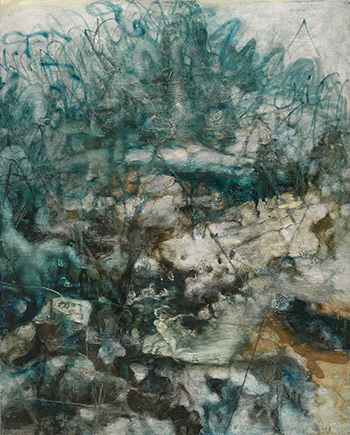Catalogue Note:
TAIHU STONE
ZHOU Chunya
“I paint stones not for considerations of images or signs, merely for interests. I like
forms of stones by ancient literati, but am not content with the overly mild and
introverted personality. So I am thinking about a kind of risky attempt, rely this kind
of elegant form to convey a kind of violent even erotic meaning.” - ZHOU Chunya
Zhou Chunya composed a series of paintings featuring unusual rocks, in which he inherited the aesthetic tradition of rock collectors in valuing “strangeness” and “peculiarity” through strong and emotional expressions in oil paint. Painted in 1999, “Taihu Stone ” was constructed by brushstrokes of heavy blue and dark black. Instead of showing the distinct contours of the rock, the artist depicted multiple dimensions revealed through overlapping colors, as though carefully carving out every bulge, hollow and detail on his canvas. And thus, the solid composition of the rock was clearly presented, as are its sharp, rugged surface and giant, weighty volume. Some dry brush strokes create a forcefulness that reminds viewers of the “dry stroke” (Feibai) in ink wash. A touch of obscure blue adds a captivating charm to the supposedly still and solid rock, which becomes vivid as though a living organism. In the heavy, dark cyan paint spreads over the canvas like wash of ink, as though foreseeing a coming storm and adding a rich theatrical effect to the whole artwork.
Taihu stone was the most famous kind of stone being used in traditional Chinese gardens. With its unique shapes, Taihu stone naturally became a key scenic feature in a garden, and attracted the interest of the literati. If the Western tradition is to carve stone, the East Asian tradition is to depict stone as it is, and Zhou Chunya remains faithful to this tradition. Zhou uses his own unique artistic lexicon to endow cold, unfriendly stone with emotion and life. This work completely overturns the elegant image of mountains and rocks in the literati tradition and accomplishes a bold masterpiece that carries the profundity of literati art.
ZHOU Chunya
“I paint stones not for considerations of images or signs, merely for interests. I like
forms of stones by ancient literati, but am not content with the overly mild and
introverted personality. So I am thinking about a kind of risky attempt, rely this kind
of elegant form to convey a kind of violent even erotic meaning.” - ZHOU Chunya
Zhou Chunya composed a series of paintings featuring unusual rocks, in which he inherited the aesthetic tradition of rock collectors in valuing “strangeness” and “peculiarity” through strong and emotional expressions in oil paint. Painted in 1999, “Taihu Stone ” was constructed by brushstrokes of heavy blue and dark black. Instead of showing the distinct contours of the rock, the artist depicted multiple dimensions revealed through overlapping colors, as though carefully carving out every bulge, hollow and detail on his canvas. And thus, the solid composition of the rock was clearly presented, as are its sharp, rugged surface and giant, weighty volume. Some dry brush strokes create a forcefulness that reminds viewers of the “dry stroke” (Feibai) in ink wash. A touch of obscure blue adds a captivating charm to the supposedly still and solid rock, which becomes vivid as though a living organism. In the heavy, dark cyan paint spreads over the canvas like wash of ink, as though foreseeing a coming storm and adding a rich theatrical effect to the whole artwork.
Taihu stone was the most famous kind of stone being used in traditional Chinese gardens. With its unique shapes, Taihu stone naturally became a key scenic feature in a garden, and attracted the interest of the literati. If the Western tradition is to carve stone, the East Asian tradition is to depict stone as it is, and Zhou Chunya remains faithful to this tradition. Zhou uses his own unique artistic lexicon to endow cold, unfriendly stone with emotion and life. This work completely overturns the elegant image of mountains and rocks in the literati tradition and accomplishes a bold masterpiece that carries the profundity of literati art.
